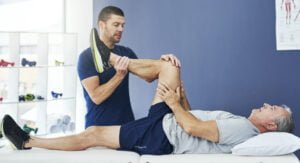Arthritis is a prevalent condition that affects millions of people worldwide, causing joint pain, stiffness, and reduced mobility. While there are various treatments available, physical therapy has emerged as a cornerstone in managing arthritis and enhancing the overall quality of life for those afflicted. This blog will delve into the role of physical therapy in alleviating arthritis symptoms, improving mobility, and ultimately enhancing the well-being of individuals living with arthritis.
Contents
Understanding Arthritis

Arthritis is a general term that encompasses a group of over 100 joint-related conditions characterized by inflammation, pain, and stiffness in the joints. The most common types of arthritis include osteoarthritis (OA) and rheumatoid arthritis (RA). OA is a degenerative condition caused by wear and tear on the joints, primarily affecting older individuals.
RA, on the other hand, is an autoimmune disorder where the immune system attacks the joints, leading to inflammation and damage. Regardless of the specific type, arthritis can severely impact a person’s ability to perform daily tasks and enjoy an active lifestyle.
Role of Physical Therapy for Arthritis Patients
Role of Physical Therapy
Physical therapy plays a pivotal role in managing arthritis by addressing pain, improving joint function, and enhancing overall mobility. The primary goals of physical therapy for arthritis are to reduce pain, increase joint range of motion, strengthen muscles, and improve overall physical function. Here’s how physical therapy achieves these goals:
- Pain Management: Physical therapists use various techniques such as manual therapy, joint mobilization, and modalities like heat and cold therapy to alleviate pain and reduce inflammation in affected joints.
- Range of Motion Exercises: Stiffness is a common symptom of arthritis, making it difficult for individuals to move their joints freely. Physical therapists design specific exercises to increase the range of motion in affected joints, helping to maintain joint flexibility and prevent further limitations.
- Strength Training: Weak muscles can exacerbate the effects of arthritis, leading to greater discomfort and limitations. Physical therapists develop tailored strength training routines that target specific muscle groups to support and stabilize joints, reducing pain and enhancing overall function.
- Functional Training: Physical therapy focuses on real-world applications, helping individuals relearn and practice daily activities such as walking, climbing stairs, and reaching overhead. This functional training aims to restore independence and confidence in performing routine tasks.
- Education and Self-Management: Physical therapists educate patients about their condition, teaching them strategies to manage pain, prevent joint deterioration, and adopt healthy lifestyle habits. This empowers individuals to take an active role in their arthritis management.
- Assistive Devices and Orthotics: In some cases, physical therapists may recommend assistive devices like canes or braces to provide additional support to affected joints, enabling better mobility and reducing strain.
Types of Physical Therapy for Arthritis

Physical therapy for arthritis encompasses a range of specialized techniques and approaches tailored to the specific needs of individuals based on the type and severity of arthritis they have. Here are some common types of physical therapy techniques used for arthritis management:
- Manual Therapy: Manual therapy involves hands-on techniques performed by a physical therapist to manipulate soft tissues and joints. Techniques such as joint mobilization and manipulation help improve joint mobility, reduce pain, and enhance range of motion. Soft tissue mobilization focuses on relieving muscle tension and improving flexibility.
- Range of Motion (ROM) Exercises: ROM exercises aim to improve joint flexibility by gently moving the joint through its full range of motion. These exercises help prevent joint stiffness and maintain joint function. They are particularly beneficial for individuals with conditions like osteoarthritis.
- Strengthening Exercises: Strengthening exercises are designed to target specific muscle groups around the affected joint. Strengthening these muscles helps stabilize the joint, reduce strain, and improve overall joint function. Strong muscles also provide better support to the affected joint, alleviating pain and enhancing mobility.
- Aquatic Therapy: Aquatic therapy takes advantage of the buoyancy and resistance of water to provide a low-impact exercise environment. This type of therapy is particularly suitable for individuals with arthritis, as it reduces stress on joints while still allowing for effective strengthening and cardiovascular workouts.
- Functional Training: Functional training focuses on improving a person’s ability to perform everyday activities. Physical therapists work with individuals to simulate and practice tasks like walking, climbing stairs, and reaching for objects. This type of training helps individuals regain confidence in their mobility and independence.
- Balance and Proprioception Exercises: Arthritis can affect balance and coordination. Balance and proprioception exercises challenge the body’s stability and help improve joint positioning awareness. These exercises can reduce the risk of falls and further joint damage.
- Modalities: Physical therapists often use various modalities to manage pain and inflammation associated with arthritis. These include heat therapy, cold therapy, ultrasound, electrical stimulation, and transcutaneous electrical nerve stimulation (TENS). Modalities can help alleviate pain, reduce swelling, and promote healing.
- Assistive Devices and Orthotics: Physical therapists may recommend the use of assistive devices like canes, crutches, or braces to provide additional support to affected joints. Orthotics, such as shoe inserts, can help improve joint alignment and reduce pressure on specific areas.
- Posture and Body Mechanics Training: Correct posture and proper body mechanics are essential for preventing unnecessary stress on joints. Physical therapists teach individuals how to maintain proper posture and body alignment during daily activities, reducing the risk of joint strain.
Overcoming Challenges and Setting Realistic Goals
Living with arthritis presents unique challenges that can impact an individual’s physical function, emotional well-being, and overall quality of life. Some of these are:
Pain and Discomfort
Arthritis often causes pain and discomfort, which can make it challenging to engage in physical activities, including therapy exercises. Fear of exacerbating pain might lead individuals to avoid movement altogether.
Motivation and Consistency
Arthritis management requires consistent effort and dedication to physical therapy exercises and lifestyle modifications. Staying motivated can be tough, especially when progress is slow or when pain flares up.
Fear of Injury
Individuals with arthritis might worry about causing further joint damage during exercises. This fear can hinder their willingness to fully participate in physical therapy.
Limited Mobility
Reduced joint mobility and stiffness can make certain exercises difficult to perform. This limitation can be frustrating and discouraging.
Emotional Impact
Living with chronic pain and physical limitations can lead to emotional challenges, including depression, anxiety, and decreased self-esteem.
Maintaining Consistency in Physical Therapy

Consistency is the backbone of successful arthritis physical therapy. While it might seem challenging at times, the gradual progress and sustained efforts can yield remarkable results. Here’s how to maintain consistency:
1. Create a Routine
Incorporate physical therapy exercises into your daily routine. Consistency becomes easier when exercises become a habitual part of your day.
2. Set Reminders
Use alarms, notifications, or even calendar entries to remind you of your therapy sessions. These cues can help you stay on track and prioritize your exercises.
3. Start Small
At the beginning of your journey, focus on manageable exercises. This approach not only prevents overwhelming yourself but also builds the foundation for more complex exercises later on.
4. Monitor Progress
Keep a journal or digital tracker to record your progress. Seeing the improvements you’ve made can motivate you to continue and reinforce your commitment.
5. Celebrate Milestones
Acknowledge your achievements, no matter how minor they might seem. Celebrating milestones boosts your confidence and keeps you engaged.
Long-Term Benefits of Physical Therapy
Some of these benefits are:
Improved Mobility
Consistent engagement in physical therapy leads to increased joint flexibility, enhanced range of motion, and reduced joint stiffness. Over time, these improvements can make everyday activities easier and more enjoyable.
2. Pain Reduction
Physical therapy exercises, when performed consistently, help strengthen muscles around affected joints. This added support can alleviate pain and reduce the strain on the joints.
3. Delayed Joint Degeneration
By maintaining strong muscles and optimal joint function, you can potentially slow down the progression of joint degeneration. This delay can contribute to a higher quality of life in the long run.
4. Enhanced Quality of Life
Regular physical therapy can empower you to regain independence and engage in activities you love. As your mobility improves, your overall well-being and enjoyment of life increase.
5. Prevention of Further Complications
Consistent physical therapy can prevent secondary complications that may arise due to arthritis. These complications might include muscle imbalances, postural problems, and joint deformities.
Debunking Common Misconceptions
Contrary to misconceptions, physical therapy isn’t solely for post-injury rehabilitation. It’s a powerful tool for arthritis management that enhances mobility and quality of life.
Misconception 1: “Exercise Will Worsen My Arthritis”
One of the most persistent misconceptions is that exercise will exacerbate arthritis symptoms. In reality, tailored exercises prescribed by a qualified physical therapist can have numerous benefits. Gentle, low-impact exercises can help improve joint function, reduce pain, and increase flexibility.
Misconception 2: “Physical Therapy is Only for Severe Cases”
Physical therapy isn’t reserved for severe arthritis cases. Early intervention through physical therapy can prevent the progression of symptoms and reduce the need for more invasive treatments down the line. Physical therapists can design personalized plans that suit your specific needs, regardless of the severity of your condition.
Misconception 3: “I Should Rest and Avoid Movement”
While rest might seem like a good idea when joints are painful, excessive inactivity can worsen arthritis symptoms. Physical therapy focuses on controlled, targeted movement to improve joint mobility, strengthen muscles, and reduce stiffness.
Conclusion
Physical therapy has emerged as a vital component in managing arthritis and enhancing the well-being of those living with this condition. By targeting pain, improving joint function, and enhancing mobility, physical therapy empowers individuals to lead more active and fulfilling lives.
If you or someone you know is affected by arthritis, consulting a physical therapist can be a crucial step toward reducing pain, improving mobility, and ultimately enhancing the overall quality of life.
Physical Therapy helps patients recover from pain. If you’re experiencing Back, Shoulder, Knee, Neck, Elbow, Hip, or Arthritis pain, a physical therapist at PhysioMantra can help: Book an online physical therapy session.



